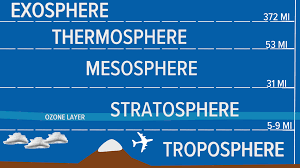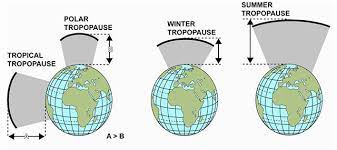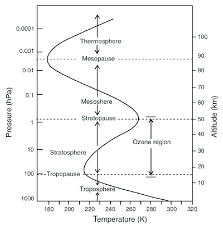The troposphere is the lowest layer of the Earth’s atmosphere, extending from the Earth’s surface up to an altitude of approximately 7-20 kilometers, depending on the location and time of year. This layer contains about 80% of the total mass of the Earth’s atmosphere and is where weather occurs. In this article, we will explore the troposphere and its characteristics in detail.

Table of Contents
What is the Troposphere?
The troposphere is the layer of the Earth’s atmosphere closest to the Earth’s surface. It is where all weather phenomena occur and where the vast majority of the Earth’s air is contained. The thickness of the troposphere varies depending on location and time of year but generally extends from the Earth’s surface up to an altitude of 7-20 kilometers.

The thickness of troposphere near equator is higher as compared to near poles. Similarly, the summer troposphere is thicker than the winter troposphere.
Temperature Gradient in the Troposphere
The temperature in the troposphere decreases with altitude, a phenomenon known as the temperature gradient. This gradient is caused by the decrease in atmospheric pressure with altitude, which causes the air to expand and cool. On average, the temperature in the troposphere decreases by approximately 6.5 degrees Celsius per kilometer of altitude.

Weather in the Troposphere
The troposphere is where all weather phenomena occur. This is because it is the layer of the atmosphere closest to the Earth’s surface, and therefore, it is the layer where the majority of the Earth’s weather occurs. The movement of air and moisture in the troposphere creates various weather patterns, including precipitation, thunderstorms, and hurricanes.
What is Tropopause
Importance
The troposphere is essential for life on Earth. It is where the vast majority of the Earth’s air is contained, and it is where all weather phenomena occur. The movement of air and moisture in the troposphere helps to distribute heat and moisture across the planet, which is essential for maintaining a habitable climate.
Conclusion
In conclusion, the troposphere is the lowest layer of the Earth’s atmosphere and is where all weather phenomena occur. The temperature in the troposphere decreases with altitude due to the temperature gradient, which is caused by the decrease in atmospheric pressure with altitude. The troposphere is essential for life on Earth, as it is where the majority of the Earth’s air is contained and where weather patterns are created. Understanding the troposphere is essential for understanding our planet’s climate and how it is changing over time.
Summary
- The troposphere is the lowest layer of the Earth’s atmosphere, extending from the Earth’s surface up to an altitude of 7-20 kilometers.
- It contains about 80% of the total mass of the Earth’s atmosphere and is where weather occurs.
- The temperature in the troposphere decreases with altitude, a phenomenon known as the temperature gradient.
- The troposphere is where all weather phenomena occur, including precipitation, thunderstorms, and hurricanes.
- The movement of air and moisture in the troposphere helps to distribute heat and moisture across the planet, which is essential for maintaining a habitable climate.
- The troposphere is essential for life on Earth, as it is where the majority of the Earth’s air is contained and where weather patterns are created.
MCQ